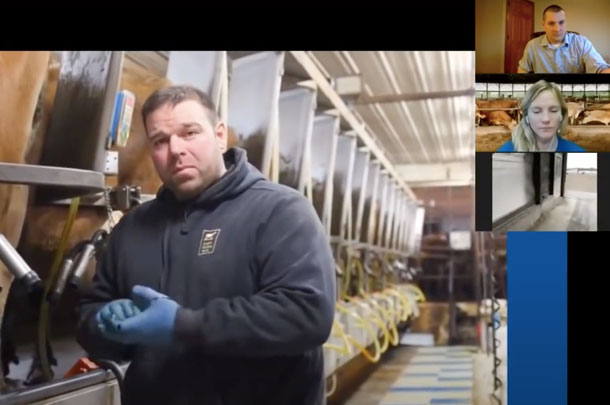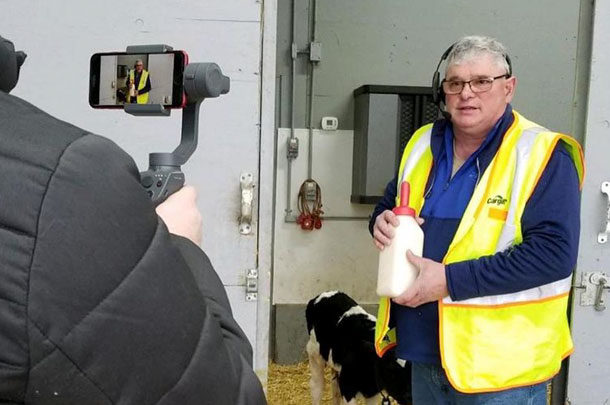Consumer awareness is top of mind for many people working in agriculture. Given the technology available, farmers are now in a unique position to connect directly with consumers and share their knowledge and individual experience. One manner in which this connection can be achieved and fostered is by hosting a virtual farm tour.
In March, daily life came to a startling halt for many as social distancing measures took effect, and schools and business across the country closed in reaction to the spread of COVID-19.
As school closures began, many dairy promotion organizations, like the American Dairy Association North East (ADANE), took to social media to showcase farms. ADANE incorporated three of their recent virtual farm tours into a resource for educators to use and show to their students in a time when in-class learning may not be possible.
ADANE began filming virtual farms tours in the fall of 2018. The tours are normally geared toward school-aged children in an effort to integrate farming into an educational setting.
Since March 2020, ADANE’s virtual farm tours have seen a large increase in viewership. In this time, over 200,000 people have viewed the recordings posted to the organization’s YouTube channel. When considering this increase in viewership, the value and the challenges of hosting a virtual farm tour should be evaluated.
Three dairy producers tell Progressive Dairy about their experience hosting a virtual farm tour.
Jolene Griffin of Valley Grove Dairy – Hastings, Michigan
Jolene Griffin works in industry relations for the United Dairy Industry of Michigan (UDIM), informing farmers about programs that connect them directly with consumers. She grew up on her family’s dairy farm and is passionate about promoting the dairy industry. On April 21, Griffin went live on the Milk Means More Facebook page to host a tour of her family’s farm, Valley Grove Dairy. The video has since received over 10,000 views.
In the 36-minute long tour, Griffin covered topics as diverse as animal care, facility management, and milk transportation and processing. The motivation to host the tour came from wanting to connect with consumers to provide a distraction from some of the stress surrounding the pandemic. “We wanted to bring this to people to give them a few minutes of time to not have to think about what was going on in the world around them,” Griffin explains. The tour was aimed at anyone interested in learning more about the dairy industry.
Griffin and her colleague Amiee Vondrasek, who helped host the tour, had prepared an outline of the tour’s talking points beforehand. They had also created some questions to ask in case technological difficulties prevented the audience from asking questions live.
Griffin is very pleased with the response the video garnered. While the video was live, viewers submitted multiple questions, some of which Griffin answered over the course of her tour. Other questions were answered in the video’s comments by other Michigan dairy producers.
The live tour was filmed using minimal equipment. Griffin used a cellphone and a video stabilizing device called a gimbal to film. She wore a noise-canceling headset, which allowed for crisper audio and minimized background noises. When speaking of the time and equipment invested to film the live farm tour, Griffin says it was well worth it. She encourages any dairy farmer contemplating the idea to reach out to their local dairy checkoff. Griffin remarks that a virtual farm tour is a great way to assure consumers that dairy farms are still operating. “We’re still here, we’re still caring for the cows, and we’re still wanting to answer their questions,” she says.
Hannah Worden of Will-O-Crest Farms – Clifton Springs, New York
Hannah Worden is part-owner of Will-O-Crest Farms. Her role on the farm is to help with the promotion of the farm and connecting to consumers and other community members through the farm’s social media.
After being approached by ADANE in late 2019, Worden filmed a virtual farm tour at Will-O-Crest Farms for children in grades fourth to sixth. She says she was excited to be contacted by ADANE and that their support and the resources they provided made hosting the tour easy.
ADANE gave Worden a few talking points to cover during the tour such as animal care and the use of eartags. Worden integrated those points into her 45-minute farm tour.
Several classrooms tuned into the tour while it was live and sent in questions for Worden to answer. Worden says, “They definitely seemed engaged and excited to see the animals.” For Worden, the tour was a great way to reach people and to engage with students who may never otherwise get the chance to see a dairy farm in action.
After reflecting on the tour, Worden would have done some things a little differently. Worden says she would have been more mindful of everything that was within the video frame when selecting her background to avoid standing in front of old bedding or other things that may not be as visually appealing. Additionally, she would have liked to put more preparation into her talking points.
During the tour, Worden relied on a few props such as a calf jacket, a gallon of milk and feed, to help make the tour more interactive. The tour took about two hours to prepare, and Worden says it was well worth the time, “I am really happy with how it turned out.”

Some parts of Nate Chittenden’s virtual farm tour had to be pre-recorded due to poor internet connection. Screenshot by Emma Ohirko.
Nate Chittenden of Dutch Hollow Farm – Schodack Landing, New York
Nate Chittenden works at Dutch Hollow Farm, which he considers a pioneer of polled Jersey genetics, along with several other members of his family. In March of 2019, Chittenden filmed his first of two virtual farm tours with ADANE after he had contacted them for some help filming a separate tour of their milking parlor.
Well aware of the fact that their farm is situated among a residential area of over 500 homes, Chittenden and his family have always strived to be as transparent and as open with their community as possible. A virtual farm tour seemed like a natural way to continue this initiative.
Chittenden, who has hosted many on-farm tours and held a number of open houses, was excited to share his farm with students in new way. “I don’t like to use the word ‘education’ because we’re not qualified to be teachers, and we’re not really trying to educate people. What we are doing is sharing what we do, how we do it and why we do it. The why is really the most important,” he says.
To film the tour, Chittenden used his cellphone and a gimbal camera stabilizer. He did a dry run of the tour first, but says the preparation was quick and simple. He says the one thing he wishes he could change is access to the internet. The reception was intermittent and did not allow all parts of the farm to be shown. Going forward, Chittenden thinks a good way continue to engage students would be to offer shorter videos that focus on one specific aspect of the farm.
Chittenden says he believes any way of sharing what is happening on his farm is a worthy investment of his time. Overall, he is happy with the tour’s response and even received a few letters thanking him for the tour. “It’s kind of fun to get some fan mail,” Chittenden says.
If you're thinking about hosting a virtual farm tour, read this article for some tips to consider.





